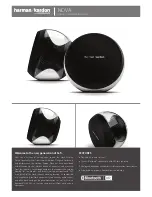
SETUP AND OPERATION
| ENGLISH
3.
SETUP AND OPERATION
3.1
INSTALLATION AND MOUNTING
Depending on the particular model,
LC
loudspeakers can
be mounted on building structures using the following wall
brackets (see Chapter 5 “Accessories”):
WAL-1, WAL-03, WLX-100, WLX-221
Loudspeaker mounting within buildings should only be car-
ried out by trained personnel.
Please ensure that the wall brackets you have selected are
suitable for use with the product to be installed.
We recommend that you read Chapters 1 and 2 of this user
manual carefully. You must also observe any relevant na-
tional safety requirements.
CONNECTION TO BUILDING STRUCTURES
• Make sure that the building structure to which the loud-
speaker will be connected is statically suitable.
• Surfaces that support brackets must be sufficiently sta-
ble and not be subject to long-term settlement.
• Wall plug and screw connections must be of sufficient
size to cope with the tensile strength required. This will
also depend on the type and inclination of the particu-
lar speaker mounting.
• If you are uncertain about any of the above points, it
is imperative to consult a qualified structural engineer.
CONNECTIONS BETWEEN LOUDSPEAKERS AND
BRACKETS
• All
FOHHN
brackets include fastening materials for
connecting them to the loudspeaker. If you want to use
other screws, their strength must be at least class 8.8;
this corresponds to a tensile strength of 800 N/mm² and
a 0.2 % proof stress of 640 N/mm².
• Never use screws that are longer than the originals
supplied. This could damage structures inside the loud-
speaker, or cause a short circuit.
• When connecting the following brackets to
LC
series
loudspeakers, a tightening torque of 10 Nm is required:
WAL-1, WAL-03, WLX-100, WLX-221
. This applies to
standardised screws without washers: DIN 912/6912,
DIN 931/933, ISO 7380.
SAFETY
• Regardless of any currently applicable legal require-
ments, we strongly recommend securing all systems to
a second separate point. Any M6 thread points on
LC
loudspeakers are suitable for this purpose. The two sets
of threads above the connection panel and on the up-
per end of the housing rear wall are specifically intend-
ed for this.
• DIN 580 C15 forged eyelets can be used for anchoring
the system.
SEE FIGURE 1.
• To secure the loudspeaker, only suitably sized permit-
ted elements (such as wire ropes, shackles or quick
links) should be used. The maximum falling distance,
before the safety element is engaged, should be as
small as possible and must not exceed 200 mm.
Figure 1
17
• When anchoring the system to the wall, dynamic
strength caused by the falling loudspeaker must also
be considered.
































